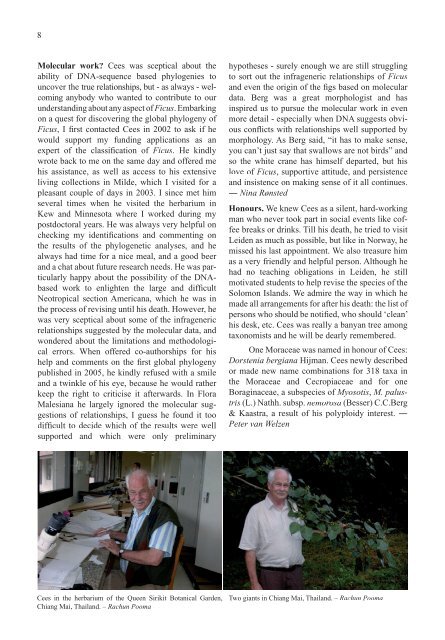Thai Forest Bulletin
Thai Forest Bulletin
Thai Forest Bulletin
Create successful ePaper yourself
Turn your PDF publications into a flip-book with our unique Google optimized e-Paper software.
8<br />
Molecular work? Cees was sceptical about the<br />
ability of DNA-sequence based phylogenies to<br />
uncover the true relationships, but - as always - welcoming<br />
anybody who wanted to contribute to our<br />
understanding about any aspect of Ficus. Embarking<br />
on a quest for discovering the global phylogeny of<br />
Ficus, I fi rst contacted Cees in 2002 to ask if he<br />
would support my funding applications as an<br />
expert of the classifi cation of Ficus. He kindly<br />
wrote back to me on the same day and offered me<br />
his assistance, as well as access to his extensive<br />
living collections in Milde, which I visited for a<br />
pleasant couple of days in 2003. I since met him<br />
several times when he visited the herbarium in<br />
Kew and Minnesota where I worked during my<br />
postdoctoral years. He was always very helpful on<br />
checking my identifi cations and commenting on<br />
the results of the phylogenetic analyses, and he<br />
always had time for a nice meal, and a good beer<br />
and a chat about future research needs. He was particularly<br />
happy about the possibility of the DNAbased<br />
work to enlighten the large and diffi cult<br />
Neotropical section Americana, which he was in<br />
the process of revising until his death. However, he<br />
was very sceptical about some of the infrageneric<br />
relationships suggested by the molecular data, and<br />
wondered about the limitations and methodological<br />
errors. When offered co-authorships for his<br />
help and comments on the fi rst global phylogeny<br />
published in 2005, he kindly refused with a smile<br />
and a twinkle of his eye, because he would rather<br />
keep the right to criticise it afterwards. In Flora<br />
Malesiana he largely ignored the molecular suggestions<br />
of relationships, I guess he found it too<br />
diffi cult to decide which of the results were well<br />
supported and which were only preliminary<br />
Cees in the herbarium of the Queen Sirikit Botanical Garden,<br />
Chiang Mai, <strong>Thai</strong>land. – Rachun Pooma<br />
hypotheses - surely enough we are still struggling<br />
to sort out the infrageneric relationships of Ficus<br />
and even the origin of the fi gs based on molecular<br />
data. Berg was a great morphologist and has<br />
inspired us to pursue the molecular work in even<br />
more detail - especially when DNA suggests obvious<br />
confl icts with relationships well supported by<br />
morphology. As Berg said, “it has to make sense,<br />
you can’t just say that swallows are not birds” and<br />
so the white crane has himself departed, but his<br />
love of Ficus, supportive attitude, and persistence<br />
and insistence on making sense of it all continues.<br />
― Nina Rønsted<br />
Honours. We knew Cees as a silent, hard-working<br />
man who never took part in social events like coffee<br />
breaks or drinks. Till his death, he tried to visit<br />
Leiden as much as possible, but like in Norway, he<br />
missed his last appointment. We also treasure him<br />
as a very friendly and helpful person. Although he<br />
had no teaching obligations in Leiden, he still<br />
motivated students to help revise the species of the<br />
Solomon Islands. We admire the way in which he<br />
made all arrangements for after his death: the list of<br />
persons who should be notifi ed, who should ‘clean’<br />
his desk, etc. Cees was really a banyan tree among<br />
taxonomists and he will be dearly remembered.<br />
One Moraceae was named in honour of Cees:<br />
Dorstenia bergiana Hijman. Cees newly described<br />
or made new name combinations for 318 taxa in<br />
the Moraceae and Cecropiaceae and for one<br />
Boraginaceae, a subspecies of Myosotis, M. palustris<br />
(L.) Nathh. subsp. nemorosa (Besser) C.C.Berg<br />
& Kaastra, a result of his polyploidy interest. ―<br />
Peter van Welzen<br />
Two giants in Chiang Mai, <strong>Thai</strong>land. – Rachun Pooma
















